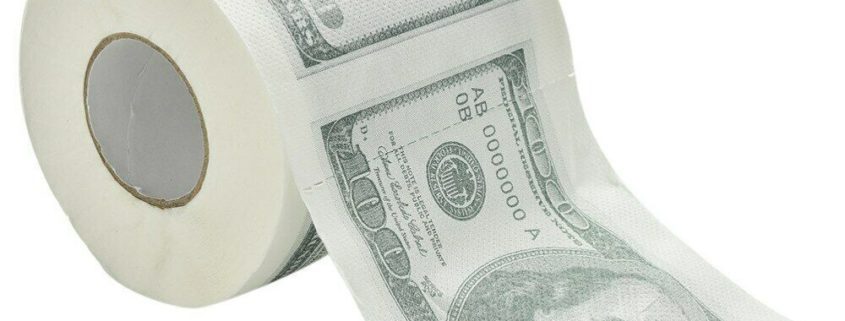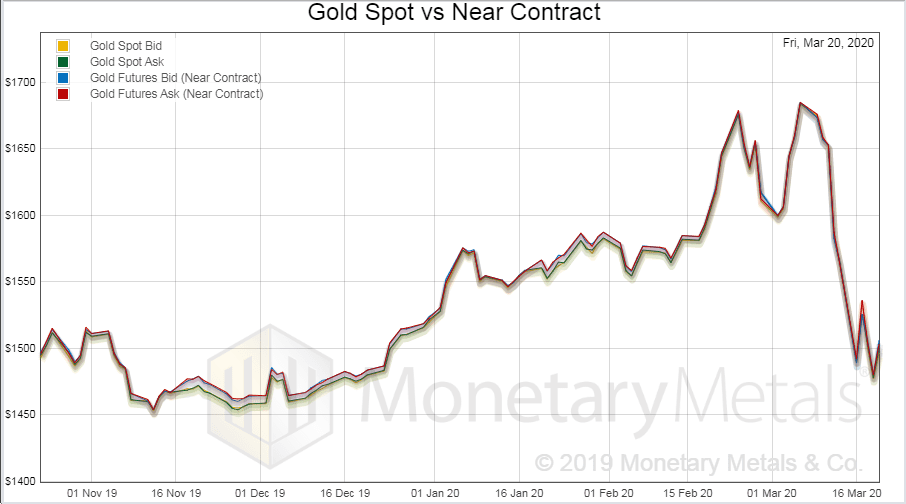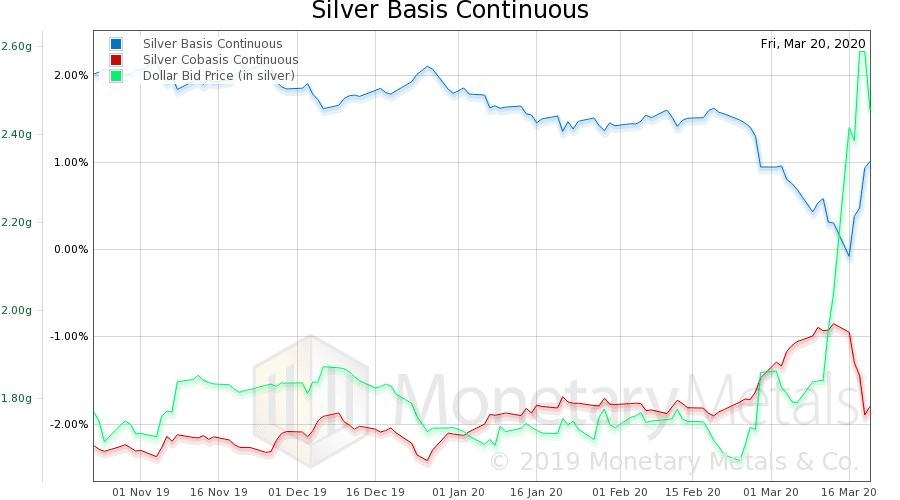Cash is Toilet Paper, Market Report 23 March
The price of gold dropped $31, and that of silver fell even more by proportion, $2.14. The gold-silver ratio hit a hit of over 126 before closing the week around 119. This exceeds the high in the ratio last hit in the George H.W. Bush recession.
Last week, we were warming up to silver, if not recommending it. We said:
“While we would not recommend betting on silver with leverage at this moment, we certainly would not be short silver right now. If you don’t own any, this looks like a good time to buy some. If you have some, you could do worse than buying more here.
…
That said, the Monetary Metals Gold:Silver Ratio Fundamental shows the fundamental as high or higher than the market ratio.
…
This should be watched for a turn. A historic opportunity is coming.”
We will look at this below. But before that, this week, we heard the term “paper gold” more times than we recall in a long time. So permit us this little rant.
<Rant>
Put three things out of your mind. They are just myths, and no good comes of adults who believe in them: Santa Claus, the Tooth Fairy, and the Shadowy Cartel Who Sells Paper Gold. There is no such thing as a piece of paper that, while unconnected to gold in any way, they sell in lieu of gold, that soaks up gold demand, or that anyone would buy.
It does not exist.
The sooner you accept the unpleasant truth that a fat man with a white beard does not fly his reindeer sleigh to your roof, where he somehow gets down your chimney with his beard unsoiled, the better off you will be. The sooner you know that if you lose a tooth, there is no magical fairy to put money (well, dollars) under your pillow, the better. The sooner you learn a bit about how the gold market works, the better you will do in your investing and trading.
Sorry if the above offends anyone. The truth sometimes gives offense (though it shouldn’t).
The price of gold in the spot market somehow tracks very closely to the price of gold in the futures market. When we say gold, we refer to commercial sized (large) bars. We will address small bars and coins, below. Did you ever wonder how this works? There is a mechanism that keeps them tightly correlated. And in markets, such mechanisms mean someone makes a profit to make it work.
Here is a graph of the price of gold in both markets (with bid and ask prices).
The spread between spot and future is so small, that one can barely see it on a price graph. One needs to see it on a basis graph.
This profit is called arbitrage. It is possible, under normal conditions, to simultaneously buy gold metal and sell a gold future—and make a profit. To make this profit, the trader—a warehouseman—carries gold. He holds the gold until the maturity of the contract, when he will have to deliver it. Or until the party who bought the contract wants to close it, often as the contract heads into expiration.
The profit that the arbitrager makes can be quoted as an annualized rate, which is the basis we publish every day.
In extraordinary conditions, it is possible to sell physical gold and buy a gold future. This is called decarrying, and the profit one makes if quoted in annualized terms is the cobasis. When the cobasis is positive, that is called gold backwardation. Backwardation should never happen in gold, ever. But it does, because the monetary system is breaking down.
These two trades, carry and decarry, keep the price of gold in the futures market very close to the price of gold in the spot market.
The price of small bars and coins, which are retail products, can vary considerably from the price of gold in the spot market. This is because manufacturing capacity, especially for minted bars and coins, is finite. Mints are reluctant to buy expensive machines (with debt financing, of course) to expand capacity for a boom that they know from prior experience can be fleeting.
So what happens when retail demand spikes above this capacity? It pulls the inventory out of the supply chain. And then demand runs into a wall. Supply is inelastic. So the premium on small bars and coins can rise, as it has now.
This says nothing about whether the gold price is fair or unfair, manipulated, suppressed, or free to move up or down. It does not say that the downward price action is somehow nefarious.
Besides, with the Fed primed to print trillions, you are a buyer of gold at $1,475 and especially silver at $12.60. Right? You are, aren’t you? Buyers are happy to see what they want to buy go on sale.
</Rant>
Obviously, the mints will ramp up to produce as much as they can. They can sell product now for a higher premium than before. I.e. it is more profitable for them than it was until recently. They operate on the same incentives as the warehousemen in the futures market.
Also obviously, they will be buying as much metal in the form of large bars as they can, to make into small bars and coins. This is marginal demand coming into the market, which hadn’t been there before.
It is noteworthy that the price jump starting last June was not only without retail buying, it occurred despite retail selling. Now, retail is buying all over the world.
However, it may be less obvious that there is selling by high net worth and institutional investors. Let’s look at why.
We have spoken with some business owners. A trend stands out to us. For example, a medical practice was, until a month ago, at or beyond its capacity to see patients. However, by this week, the doctors were going home early. There are no more elective surgeries. And patients are cancelling even permissible office visits.
This medical practice is now seeking to open a credit line (whether any bank will extend new credit right now, remains to be seen). They anticipate that they may have a cash flow crunch and seek to put cash on their balance sheet now, while they can.
We believe this must be the same thought going through the heads of every business manager, everywhere.
Businesses seek to stock up on cash, the way consumers are seeking to stock up on toilet paper. And for the same reason—fear that tomorrow, it may not be available.
And this brings us back to gold. If you need cash, and you have both real estate and gold, which do you sell? Gold has a bid. If you need cash, and you have both BBB bonds and gold, which do you sell?
Gold is serving its time-tested role: preserving wealth, especially in times of crisis. Unlike real estate, which anyone who needs to sell urgently right now will soon discover. If there is a bid on real estate at all, it may be a very weak bid.
This is the first of two major forces in the gold market. Gold sellers are desperate to raise cash.
The buyers should be obvious to observers of the gold space. Everyone knows that a one-two punch is coming to hit the dollar. Fiscal policy may include $1,000 checks to everyone, bailouts to the banks, and subsidies to businesses large and small. All paid for with borrowed dollars, of course. Monetary policy will include more Fed asset purchases, perhaps including overpaying for impaired bonds. The Fed will expand its balance sheet massively, and keep pushing interest rates down.
This is the second major force in the gold market. Gold buyers seek to avoid this coming dollar disaster.
In the end, buyers will have to win. But in the short term, desperate sellers can push the price from $1,700 to $1,500 (and silver from $18 to $12).
Are you a buyer or a seller?
Here is a graph of the silver basis and price of the dollar in silver (which is the inverse of the price of silver in dollar terms).
As the dollar rises (i.e. price of silver drops) we see a drop in the scarcity of silver (i.e. cobasis, the red line). A big drop. Silver became much less scarce in this selloff.
It should be obvious what this means. For every monster box of coins bought at retail, desperate sellers are selling a 1,000oz bar. Sorry, but the truth is the truth (and if you don’t agree, we encourage you to write your own theory based on the same facts: (1) big price drop, (2) retail buying of coins, (3) big drop in cobasis, and (4) desperate rush to raise cash from all parties).
The one consolation is that on Friday, we see a drop in the dollar (i.e. silver went up) and the scarcity rose also. Slightly. Price in this market is not set in the paper silver world. It is about buying and selling of metal bars and coins.
That historic opportunity did not come this week, though Friday’s turn may indicate it is close.
© 2020 Monetary Metals










Keith, accepting the logic and merit of that assessment, we do still need to understand the persistent market-crashing tactics such as no rational seller would contemplate. I am referring to the periodic offers of a cajillion ounces into illiquid, often holiday-related futures markets that can’t possibly absorb the volume without major price dislocation. Please explain who is doing what to whom, and why? Dan
I love the title and I hoped you would expand more on that idea. Everyone is hoarding so much toilet paper now, so it probably has a high stock-to-flow ratio and is the most marketable commodity, and could potentially be the extinguisher of debts. And there’s an unverified post on the internet about a restaurant accepting it as currency: https://www.reddit.com/r/Bitcoin/comments/feg6t7/craptocurrency/
P.S. There’s a typo in the first paragraph: “The gold-silver ratio hit a hit”
Digi Dan, I gave this matter some thought a couple years ago. By piecing together facts with logic, I will tell you my conclusion. It is not an intentional market-crashing tactic and the seller is entirely rational. It is difficult to impossible to find this explained anywhere so I won’t certify that this is entirely true.
You need to understand the mechanics of the repo market. Briefly, banks need to satisfy cash liquidity ratio requirements every day. If a bank comes up short of the cash it needs it seeks to borrow it from one that has an excess of cash. It could call a few thousand banks looking for an overnight loan, but instead a “repo clearinghouse” is run by JP Morgan. Banks which have cash to lend will post the list of collateral they are willing to accept and banks that need loans will offer what they have what from that list as collateral. Collateral might be Treasury bills, notes, bonds, corporate paper, or gold. This potential collateral is already on deposit with JP Morgan so it is already being held in “street name”, i.e. JPM. In normal times of course paper instruments are used. But in times of panic or tight liquidity the interest rate is rapidly moving all over the place and no lender wants to make a loan at 10% if they could get 25% a few minutes later. But there is always a bid for gold so its price is known. So that is what is accepted for collateral (“gold” being paid-up Comex warrants, etc.) Now the lending bank wants dollars, not gold, so it tells JPM to sell it (and buy a call to cover its collateral commitment?). Of course other banks taking gold collateral have given the same order to JPM also. JPM can’t favor one bank’s order over another, so it puts in one order to sell, say, 20 tonnes of gold at 3:01 AM. There is no “working the order” to try to get a better price. The big players in the global gold market know what’s going on and will drop bids through the floor.
Anyway, that’s my conclusion. If anyone actually knows how it works, please post and feel free to correct anything I “know”.
Thanks, Donald. You describe a repo margin call. I guess it’s possible, but I would have thought the professionals would describe that way from time to time. I’m skeptical. The name(s) of the seller(s) are always known or easily identified by insiders, but we never learn them or any other details of these pink-elephant trades when they happen.
Is it possible that the supply of spot gold and silver can be artificially increased by the issuance of “unallocated” paper contracts? If so, wouldn’t this issuance of unallocated contracts apply greater downward pressure on the spot price (increasing the basis) than if the spot price were based on actual physical metal?
Yes. I have made this point on here in comments on past articles. The response was along the lines of “show me anywhere, where I can sell my gold higher than the quoted spot price”. It’s a tough thing to rebut as the problem would not become evident until a severe crisis and mass requests for physical redemption overwhelmed the ability the redeem physical by the custodians.
Ronan Manly and Koos Jansen at Bullion Star did a very good study years back. Many physical gold ETFs and foreign central banks claimed to have their physical gold at the bank of England. The authors tallied up the numbers of total reported “gold held in custody” versus “gold claims” in the LBMA / Bank of England system. The numbers simply did not add up. Of course, some gold could have been voluntarily (or involuntarily?) leased out. Still, the study raised a lot of doubts about the ability to make good on physical delivery if there was a sudden mass request.
There is also a very large component of spot gold trading conducted in foreign exchange cross pairs.
Example: Japanese trader sells yen at the bid of the JPY/XAU in the forex market, pays the ask of XAU and holds a “gold” balance with a broker dealer, which is likely severely unallocated.
The potential scale of this is why there are some so called “conspiracy theorists” saying that if the problem were to be large enough – There could be a sudden “cash settlement” of the outstanding gold claims rather than physical settlement. Likely the settlement would occur on a Sunday night or on a “bank holiday”.
If suddenly all of these entities / individuals who thought they “owned gold” realize they do not, you could in theory have a sudden gold price spike a large order of magnitude higher.
Never have seen Keith successfully rebut it. It’s difficult because it is essentially unprovable until when / if it were to occur.
I don’t think you need to be a conspiracy theorist to conclude that “spot” supply is increased due to unallocated settlement. The concept of “unallocated” is possible only with monetary metals because it is hoarded rather than consumed.
Hello,
Can anyone explain or make a comment about zerohedge articles saying there is a lack of gold because the futures are much higher than the spot?
I mean, i though that there is a lack of gold when it is the opposite (backwardation). Even the “fundamental price” at $1201 show that they are wrong.
Mr. Keith points out the truly obvious. For every buyer, a seller. That’s how markets work. After seeing a period in which prices increase, all one can say is that buyers were (in that time frame) more urgent in their bidding than sellers were in their selling, and therefore buyers were more dominant in controlling the price action. Thus, higher prices.
See how simple this is?
Of course the reverse is also true. Stay tuned on that score! We have the entire retail market — us included for the most part — absolutely foaming at the mouth thinking that higher prices are a DONE DEAL…. but we have YET to exceed the previous high near $1700. This has the potential to be VERY bearish. I’ll concede this however — if gold closes the week/month above $1700 I will grant my fellow bulls their due. Until then color me: Skeptical. And until such time as price confirms the bullish interpretation, I am a seller.
I understand there are also some supply chain disruptions because the London and NY exchanges have different bar size standards, and the smelter that would normally melt one kind and cast the other is closed due to COVID.
https://www.nasdaq.com/articles/exclusive-cme-pushed-to-change-gold-delivery-rules-amid-coronavirus-lockdown-sources-2020
Your basis/cobasis arguments are interesting, but they pre-suppose the shorts in a given trade can actually deliver. Once supply tightens (like now) , and delivery failure becomes increasingly likely – your argument has no merit.
Your idea inventory is somehow being pulled out of the system, thus creating the shortage – is a specious one. There is more gold above ground right now than at any point in Human history. The only plausible explanation for the shortage is the comex quoted price is false. There can be no doubt if the comex price quoted tomorrow for Gold was $20,000 or silver $500 – we would have all the supply we need. As such, the shortage is a matter of price – nothing else.
Appreciate all you do, enjoy your articles very much.